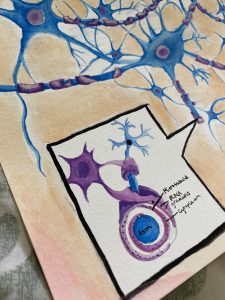For my STEAM project, I chose to dig a little deeper in to Multiple Sclerosis (MS). MS is an autoimmune disease that attacks the myelin sheath coverings on the axons of nerve cells. The myelin sheath acts as an electrochemical insulator to help transmit signals to the body, so when the it is damaged, neurons can’t send signals properly, if not at all. In my watercolor depiction of the nerve cells in an individual with MS, there is obvious cracking of the sheath. Once that sheath is broken the electrical signals can leak right out of those empty gaps. I also added a “zoomed in” cross section of the axon to show the structure.



I personally haven’t known or heard much about multiple sclerosis before. What I have learned is that people who don’t have multiple sclerosis have neurons whose nerve covering, otherwise known as myelin sheaths, are not damaged. Those who have this rare disease, less than two hundred thousand cases in the United States reported yearly, have damaged nerve coverings on their neurons. The cause of this disease is yet to be found, however, what is known is that this is considered an autoimmune disease where the immune system attacks its own tissues. Because of this malfunction, the body tears apart the fat substances which coat and defend the fibers of nerves in the central nervous system which stems from the brain into the spine. There are multiple symptoms of multiple sclerosis. Some of the most common ones are pains in the back or eyes, balance problems, dizziness, bladder and bowel dysfunction, cognitive problems, fatigue and weakness, and sexual dysfunction. A cure for this disease is still being sought out, in the meantime treatment can help with speeding up the recovery process from multiple sclerosis attacks allowing the symptoms to be more manageable. Treatments include medications prescribed by a psychiatrist, therapy, and self-care. I hope that soon a permanent cure is found, I can only imagine the pain the people experience having this disease. The watercolor piece does a good job of depicting what a portion of the neural network may mirror. The “zoomed in†section is also a nice touch which labels what neurons consist of within.